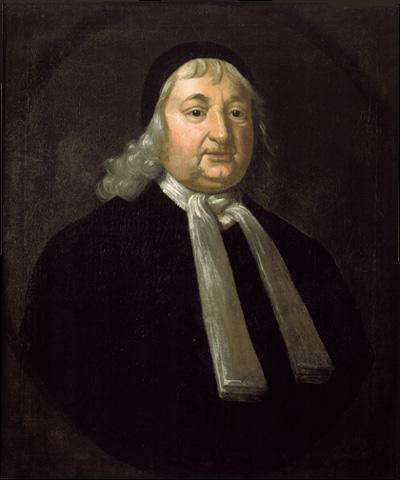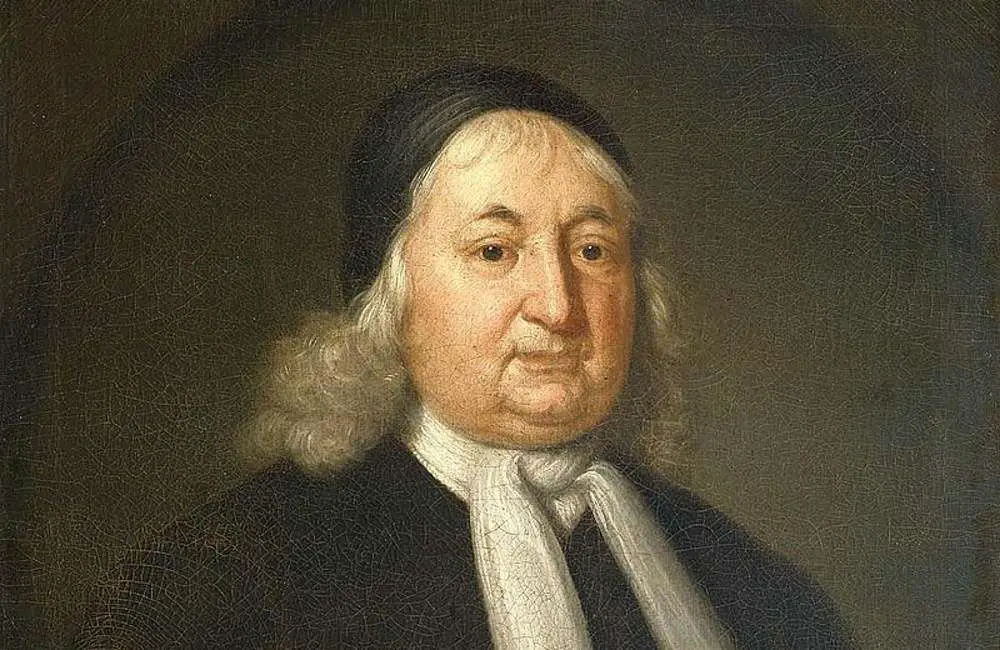Samuel Sewall is best known as one of the nine judges who condemned witches to death in the Salem witch trials of 1692 – an act for which he later apologized. His detailed diary records many of the actions and thoughts of a life that spanned 77 years from 1652 to 1730.
Some of the more humorous entries – at least from an onlooker’s perspective – describe his troubles getting remarried as a widower.
Not So Lovelorn — At First

Samuel Sewall
Samuel Sewall was profoundly lucky in love as a young man. In 1676 he married Hannah Hull, a young woman very much in love with him.. Hull was the daughter of John Hull, the first mint master of Massachusetts—a position that made Hull very wealthy.
With his wealthy family connections Sewall, a lawyer, easily rose in power and stature. By 1717, however, when Hannah died, the old man was viewed as less of a catch by the women of Massachusetts.
Indeed, Samuel Sewall notes in February of 1717 that following his wife’s burial, “This morning wondering in my mind whether to live a single or a married life.” And in his diary in July of 1718 he writes that “twas hard to know whether to marry again or no; whom to marry …”
But there was pressure to be married in those times. One of the Mathers sent Sewall a tract: Marah Spoken To: A Brief Essay to do Good Unto the Widow. Expectations were that Sewall would not only remarry, but that he would find a respectable match. And among the women of Sewall’s day, there were many matchmakers.
Sewall fended them off with humor: “… They that put to sea should be careful how they put to sea again, especially in wintertime.”
Mrs. Denison
Nevertheless, Samuel Sewall did decide to put to sea once again. His first efforts at finding a match led him to a Mrs. Denison of Roxbury. Sewall had handled her husband’s affairs, including drawing up his will, and he knew of her financial conditions. She was a shrewd lady herself, about 15 years younger than Sewall, and apparently felt Sewall was no bargain.
Sewall writes of visiting Mrs. Denison and eating curds with her. He notes: “I gave her two cases with a knife and fork in each, one with turtle-shell tacking, the other with ivory handles.”
By now, Sewall’s friends expected marriage, but the lady broke it off – offering to return all his gifts. His diary notes that in November 30 of 1718 she did apparently have a change of heart. Visiting him with her cousin, “she asked pardon if she offended me. She seemed inclined the match should not break off, since I had kept her company so long.”
But Samuel Sewall had moved on. In 1719 he successfully courted and married Abigail (Melyen) Woodmansey Tilley. This marriage lasted only a couple months, however, before Abigail died.
Catherine Winthrop
Unbowed by this second death, Samuel Sewall again pushed forward with his romantic endeavors. He next set his sights on a member of the Winthrop clan – Catherine Winthrop, widow of Wait Winthrop. At their first meeting in October of 1720, Catherine dealt rather coyly with Sewall. She kept him waiting and then she informed him that she would never move from her home and needed to take care of her grown children.
He tried to feel her out about her answer if he proposed marriage. Her reply: “She could not answer until she was asked.” Samuuel Sewall left her with a book, The Fountain Opened, and proposed to visit again in a week.
Later, Sewall notes: “I visited Madam Winthrop who treated me with a great deal of courtesy; wine, marmalade.”
A series of future visits found Catherine Winthrop treating Samuel Sewall well, solicitously sending her servant Juno to walk him home with a lantern to light the way. But she also took aim at some of Sewall’s personal shortcomings. He should keep a coach, she prodded, and suggested he might do well to buy himself a wig.
No Juno for Samuel Sewall
Just weeks into his courtship, Samuel Sewall found things growing colder. During a tedious evening on October 21, Sewall asked when they might make their courtship public, and Catherine said it would probably never be made public. Sewall rose to leave around 11 o’clock. “She offered not to help me. I prayed that Juno might light me home. She opened the shutter and said was pretty light abroad; Juno was weary and gone to bed. So I came home by starlight as well I could.”
On November 4, Samuel Sewall offered Catherine Winthrop a gift. “I asked Madam what fashion necklace I should present her with. She said none at all.”
On November 7, Sewall made one final attempt. “I told her I loved her, and was so fond as to think she loved me.” As the fire died out, Sewall noted, Madam Winthrop made no effort to revive it, or to suggest she had any affection for him. While colonial women didn’t have to marry any suitor who asked, they were expected to be polite – a sometimes painfully slow process to discourage an unwelcome suitor.
Samuel Sewall, Happy At Last
Samuel Sewall next made a brief attempt at courting a Mrs. Ruggles. Perhaps aware of his reputation for persistence, she cut him off short and allowed him no opportunity to come visiting.
Finally in 1722, 63-year-old Samuel Sewall successfully found one last wife, Mary Shrimpton Gibbs, a widow in her mid-50s. He found happiness with her for the last eight years of his life. She then outlived him by 16 years.
This story about the romantic adventures of Samuel Sewall was updated in 2023. If you’re interested in the life of this notable Puritan, you may want to read about his apology for his role in the Salem witch trials here or his experience of the Boston smallpox epidemic of 1721 here.

6 comments
[…] all the accusations levelled at Rhoda, there was no effort to officially punish her. After William died, she moved to […]
[…] that Eunice's crimes met the legal requirements for a finding that she was a witch, the court did conclude that their was reasonable suspicion that she had "familiarity with the […]
[…] Sewall’s first wife died, he tried, often without success, to woo a new one. One of his targets, Catherine Winthrop, told him he needed a wig. He declined […]
[…] He joined his father in business and continued the family's rise by marrying the granddaughter of Samuel Sewall, one of the Salem witch trials […]
[…] came from a prominent New England family. Her great-great grandfather was Salem witch trial judge Samuel Sewall. Dorothy Quincy, her great aunt, had married John Hancock. Her brother, Samuel May, was a well-known […]
[…] all the accusations leveled at Rhoda, no one tried to officially punish her. After William died, she moved to Vermont, […]
Comments are closed.